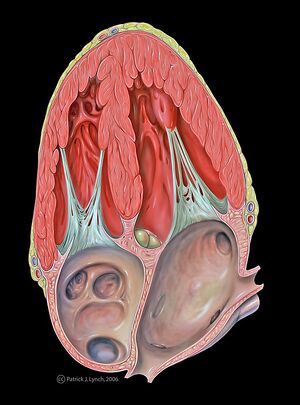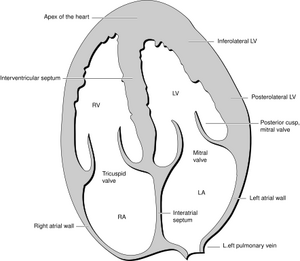Apical 4 chamber: Difference between revisions
No edit summary |
|||
| (5 intermediate revisions by 2 users not shown) | |||
| Line 1: | Line 1: | ||
{{DevelopmentPhase}} | |||
{{auteurs| | |||
|mainauthor= [[user:Vdbilt|I.A.C. van der Bilt]] | |||
|moderator= [[user:Vdbilt|I.A.C. van der Bilt]] | |||
|supervisor= | |||
}} | |||
==How to Get a Good Apical Four Chamber View== | ==How to Get a Good Apical Four Chamber View== | ||
The apical four chamber view is found by placing the transducer on the apex of the heart, near the apical impulse. The general rotation of the heart can be seen in the [[Parasternal long axis]] and one can follow a line to the apex of the heart on the patient's left side. Often it helps if the patient rotates to their left so that the heart becomes closer to the transducer. | [[File:Heart apical 4c anatomy.jpg|thumb|An apical four chamber view of the heart]] | ||
==Characteristics of a Good Apical Four Chamber View== | [[File:Heart_apical_4_chamber.svg|thumb]] | ||
The apical four chamber view is found by placing the transducer on the apex of the heart, near the apical impulse. The general rotation of the heart can be seen in the [[Parasternal long axis]] and one can follow a line to the apex of the heart on the patient's left side. Often it helps if the patient rotates to their left so that the heart becomes closer to the transducer. | |||
==Purposes and Characteristics of a Good Apical Four Chamber View== | |||
This view is important in the assessment of size and function of the ventricles, atria, and the vascular structure and function. It also allows the visualization of the septal and lateral free walls and the apex of the left ventricle. The mitral and tricuspid valve and the interventricular and interatrial septa are also seen. In an ideal apical four chamber view, the apex of the left ventricle is at the center of where the septum and lateral wall meet. | This view is important in the assessment of size and function of the ventricles, atria, and the vascular structure and function. It also allows the visualization of the septal and lateral free walls and the apex of the left ventricle. The mitral and tricuspid valve and the interventricular and interatrial septa are also seen. In an ideal apical four chamber view, the apex of the left ventricle is at the center of where the septum and lateral wall meet. | ||
The atria and apex of the heart can be observed in the image’s lower and upper regions, respectively. The left and right cavities of the heart and their respective atrio-ventricular valves are found in the right and left regions of the image, respectively. | The atria and apex of the heart can be observed in the image’s lower and upper regions, respectively. The left and right cavities of the heart and their respective atrio-ventricular valves are found in the right and left regions of the image, respectively. | ||
Usually, the mitral valve can be seen at a slightly higher position than the tricuspid valve. To identify ventricular chambers properly, bear in mind the correct location of the leaflets: the anterior mitral leaflet is near the | Usually, the mitral valve can be seen at a slightly higher position than the tricuspid valve. To identify ventricular chambers properly, bear in mind the correct location of the leaflets: the anterior mitral leaflet is near the cephalic edge of the septum, inserting into the left atrio-ventricular groove, and the septal leaflet of the tricuspid is below the anterior mitral leaflet. | ||
==Example of an Apical Four Chamber view== | ==Example of an Apical Four Chamber view== | ||
By convention the probe is positioned with the marker to the patient's left axilla so that the left ventricle is shown on the viewer's right side. In the picture the left ventricle is on the top right with the left atrium opening into it through the mitral valve, and the right ventricle is on the left side with the right atrium opening into it through the tricuspid valve. This view is useful to compare the | By convention, the probe is positioned with the marker to the patient's left axilla so that the left ventricle is shown on the viewer's right side. In the picture, the left ventricle is on the top right with the left atrium opening into it through the mitral valve, and the right ventricle is on the left side with the right atrium opening into it through the tricuspid valve. This view is useful to compare the sizes of the left and right ventricular walls and to find out whether or not a pericardial effusion is present. If a pericardial effusion is present then a dark (non-echogenic) space will be seen between the outer ventricular walls and the pericardial sac. | ||
{{IncludeFlash | {{IncludeFlash | ||
|flash_string=<flash>file=A4C_normal.swf|quality=best|align=center|width=300|height=200</flash> | |flash_string=<flash>file=A4C_normal.swf|quality=best|align=center|width=300|height=200</flash> | ||
| Line 15: | Line 26: | ||
}} | }} | ||
{{clr}} | {{clr}} | ||
==Sources== | |||
<biblio> | |||
#Zamorano isbn=1848824203 | |||
#Feigenbaum1 isbn=0781795575 | |||
#Nihoyannopoulos isbn=1848822928 | |||
</biblio> | |||
==External links== | |||
* [https://www.techmed.sk/en/echo/view/14/ A4C - Image & video (TECHmED)] | |||
Latest revision as of 13:52, 9 January 2021
Content is incomplete and may be incorrect. |
| Author | I.A.C. van der Bilt | |
| Moderator | I.A.C. van der Bilt | |
| Supervisor | ||
| some notes about authorship | ||
How to Get a Good Apical Four Chamber View
The apical four chamber view is found by placing the transducer on the apex of the heart, near the apical impulse. The general rotation of the heart can be seen in the Parasternal long axis and one can follow a line to the apex of the heart on the patient's left side. Often it helps if the patient rotates to their left so that the heart becomes closer to the transducer.
Purposes and Characteristics of a Good Apical Four Chamber View
This view is important in the assessment of size and function of the ventricles, atria, and the vascular structure and function. It also allows the visualization of the septal and lateral free walls and the apex of the left ventricle. The mitral and tricuspid valve and the interventricular and interatrial septa are also seen. In an ideal apical four chamber view, the apex of the left ventricle is at the center of where the septum and lateral wall meet.
The atria and apex of the heart can be observed in the image’s lower and upper regions, respectively. The left and right cavities of the heart and their respective atrio-ventricular valves are found in the right and left regions of the image, respectively. Usually, the mitral valve can be seen at a slightly higher position than the tricuspid valve. To identify ventricular chambers properly, bear in mind the correct location of the leaflets: the anterior mitral leaflet is near the cephalic edge of the septum, inserting into the left atrio-ventricular groove, and the septal leaflet of the tricuspid is below the anterior mitral leaflet.
Example of an Apical Four Chamber view
By convention, the probe is positioned with the marker to the patient's left axilla so that the left ventricle is shown on the viewer's right side. In the picture, the left ventricle is on the top right with the left atrium opening into it through the mitral valve, and the right ventricle is on the left side with the right atrium opening into it through the tricuspid valve. This view is useful to compare the sizes of the left and right ventricular walls and to find out whether or not a pericardial effusion is present. If a pericardial effusion is present then a dark (non-echogenic) space will be seen between the outer ventricular walls and the pericardial sac.
| <flash>file=A4C_normal.swf |
| Apical 4 chamber view of a normal heart |
Sources
<biblio>
- Zamorano isbn=1848824203
- Feigenbaum1 isbn=0781795575
- Nihoyannopoulos isbn=1848822928
</biblio>

